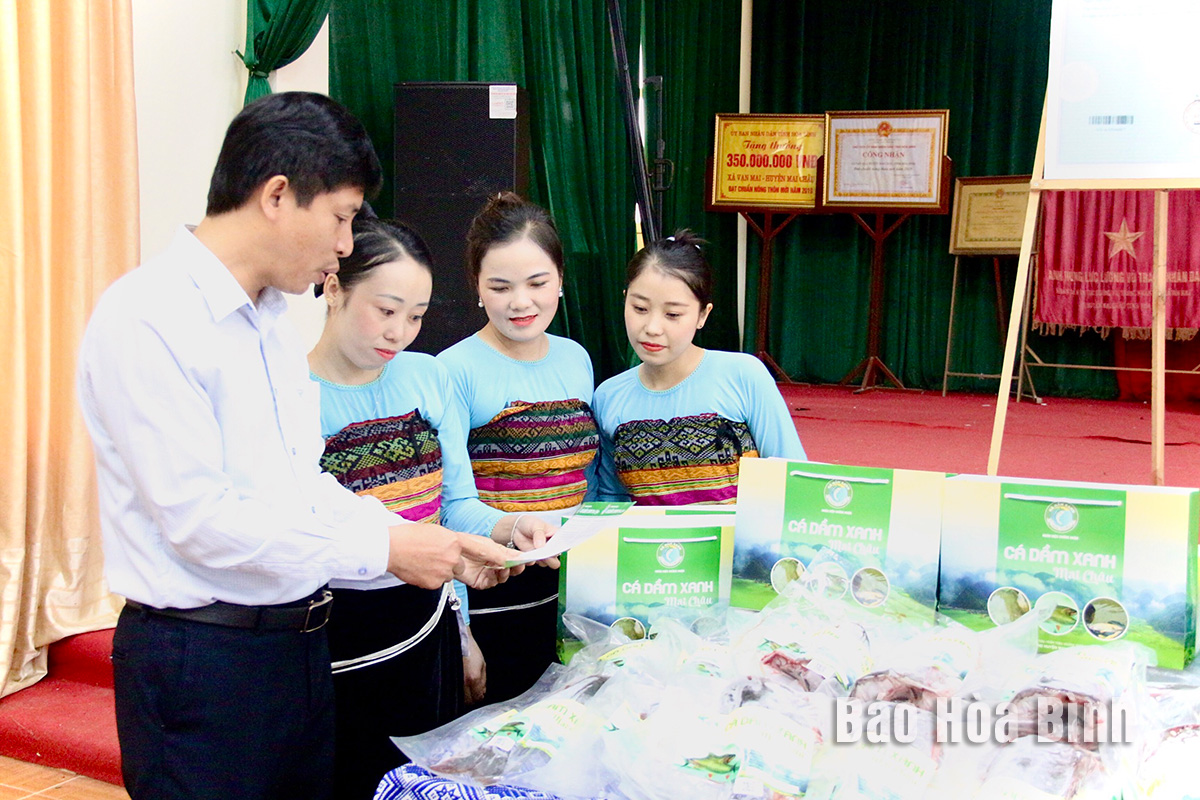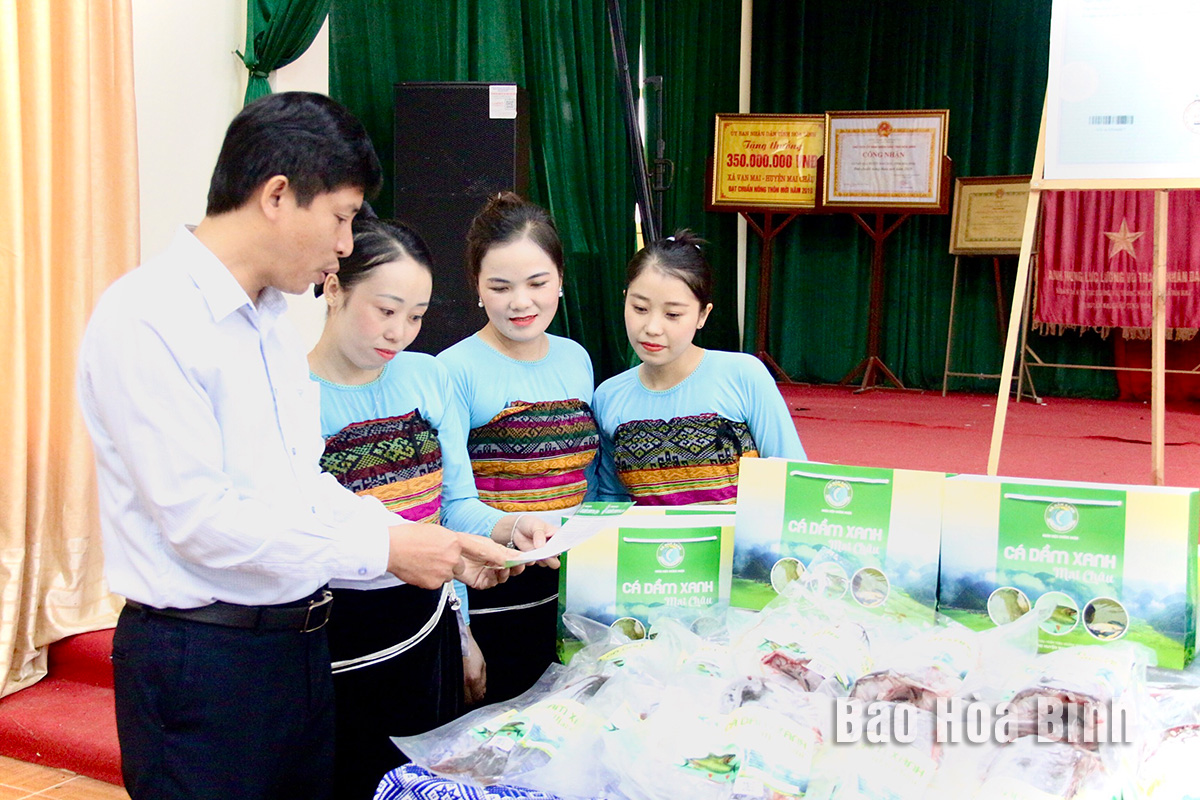
The cultivation of Dam Xanh fish (Bangana lemassoni), a unique fish species, has seen remarkable growth in Mai Chau district, thanks to its high economic value and effectiveness. Initially concentrated in Van Mai commune, farming has now extended to four other communes, namely Mai Hich, Mai Ha, Chieng Chau, and Son Thuy. These areas benefit from pristine underground water flowing from mountain crevices, providing ideal conditions for raising this specialty fish.

Staff of the
Centre for Application and Scientific Information under the provincial Department
of Science and Technology guide people on how to introduce and trace the origin
of Mai Chau district's Bangana lemassoni fish products.
Despite its reputation as a sought-after delicacy, annual
production primarily serves a limited market of local visitors and tourists in
Mai Chau.
According to Kha Van Sanh, Chairman of the Van Mai communal
People's Committee, ca dam xanh, also known as Bong fish, is a signature
specialty of Mai Chau. The fish thrives only in clean water environments,
making it unsuitable for cultivation in typical ponds, lakes, or rivers.
Although slow to mature, its meat is prized for its exceptional sweetness and
flavour, offering significant economic potential. In recent years, local
authorities have promoted commercial farming, helping residents gradually
improve their incomes.
To bring this unique fish to a broader market, the Mai Chau
district People's Committee has partnered with the Centre for Application and
Scientific Information under the provincial Department of Science and
Technology. This collaboration successfully established the trademark "Mai
Chau district’s Bangana lemassoni fish", enhancing its market presence.
Ha Trung Thao, Vice Chairman of the Mai Chau district
People's Committee, emphasised the importance of protecting and promoting
products with distinctive regional characteristics. By supporting farmers in
building certified trademarks, local authorities have expanded the reach of ca
dam xanh, boosting its value and contributing to the district's socio-economic
and tourism development.
Before the trademark's establishment, farmers faced numerous
challenges, including low competitiveness and market instability, noted Tran
Dinh Thang, Deputy Director of the Centre for Application and Scientific
Information. Despite the fish’s high quality, the lack of branding and
organised distribution limited growth. Now, with certification and a clear
brand identity, dam xanh fish benefits from improved marketing, traceable
origins, and expanded distribution networks.
Kha Van Tu, Chairman of the Van Mai Commune Farmers'
Association, shared that since receiving the collective trademark
certification, demand for the fish has surged. Although priced between 200,000
and 300,000 VND (7.8–11.8 USD) per kilogram, sales volumes have increased
three- to fourfold for households in the commune. Moreover, the customer base
has expanded from local residents and restaurants to buyers from other areas,
highlighting the growing appeal of this specialty.
According to data from the Hoa Binh Provincial Party Committee, the industrial production index for the first six months of 2025 is estimated to have increased by 20% compared to the same period last year. This marks the highest year-on-year growth rate for this period since 2020.
In the first six months of 2025, Hoa Binh province’s export turnover was estimated at 1.145 billion USD, marking an 18.11% increase compared to the same period in 2024. Import turnover was estimated at $ 804 million, a 17.15% increase, which helped the province maintain a positive trade balance.
The lives of the ethnic minority farmers in Tan Lac district have gradually improved thanks to the new directions in agricultural production. This is a testament to the collective strength fostered through the professional associations and groups implemented by various levels of the district’s Farmers’ Union.
With the motto the "product quality comes first,” after nearly one year of establishment and operation, Muong village’s Clean Food Agricultural and Commercial Cooperative, located in Cau Hamlet, Hung Son Commune (Kim Boi district), has launched reputable, high-quality agricultural products to the market that are well-received by consumers. The products such as Muong village’s pork sausage, salt-cured chicken, and salt-cured pork hocks have gradually carved out a place in the market and they are on the path to obtaining the OCOP certification.
In the past, the phrase "bumper harvest, rock-bottom prices" was a familiar refrain for Vietnamese farmers engaged in fragmented, small-scale agriculture. But today, a new spirit is emerging across rural areas of Hoa Binh province - one of collaboration, organisation, and collective economic models that provide a stable foundation for production.
Maintaining growing area codes and packing facility codes in accordance with regulations is a mandatory requirement for agricultural products to be eligible for export. Recently, the Department of Agriculture and Environment of Hoa Binh province has intensified technical supervision of designated farming areas and packing facilities to safeguard the "green passport" that enables its products to access international markets.



